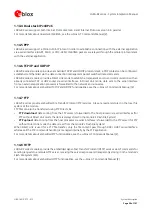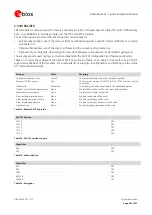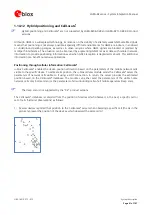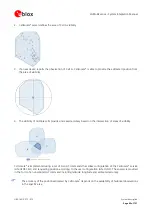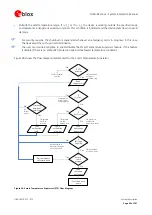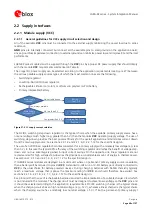
LARA-R2 series - System Integration Manual
UBX-16010573 - R12
Design-in
Page 68 of 157
2.2
Supply interfaces
2.2.1
Module supply (VCC)
2.2.1.1
General guidelines for VCC supply circuit selection and design
All of the available
VCC
pins must be connected to the external supply minimizing the power loss due to series
resistance.
GND
pins are internally connected but connect all the available pins to solid ground on the application board,
since a good (low impedance) connection to external ground can minimize power loss and improve RF and thermal
performance.
LARA-R2 series modules must be supplied through the
VCC
pins by a proper DC power supply that should comply
with the module
VCC
requirements summarized in Table 6.
The proper DC power supply can be selected according to the application requirements (see Figure 27) between
the various possible supply sources types, of which the most common ones are the following:
Switching regulator
Low Drop-Out (LDO) linear regulator
Rechargeable Lithium-ion (Li-Ion) or Lithium-ion polymer (Li-Pol) battery
Primary (disposable) battery
Main Supply
Available?
Battery
Li-Ion 3.7 V
Linear LDO
Regulator
Main Supply
Voltage > 5V?
Switching Step-Down
Regulator
No, portable device
No, less than 5 V
Yes, greater than 5 V
Yes, always available
Figure 27: VCC supply concept selection
The DC/DC switching step-down regulator is the typical choice when the available primary supply source has a
nominal voltage much higher (e.g. greater than 5 V) than the modules
VCC
operating supply voltage. The use of
switching step-down provides the best power efficiency for the overall application and minimizes current drawn
from the main supply source. See sections 2.2.1.2 and 2.2.1.6, 0, 2.2.1.12 for the specific design-in.
The use of an LDO linear regulator becomes convenient for a primary supply with a relatively low voltage (e.g. less
than 5 V). In this case the typical 90% efficiency of the switching regulator diminishes the benefit of voltage step-
down and no true advantage is gained in input current savings. On the opposite side, linear regulators are not
recommended for high voltage step-down as they dissipate a considerable amount of energy in thermal power.
See sections 2.2.1.3 and 2.2.1.6, 0, 2.2.1.12 for the specific design-in.
If LARA-R2 series modules are deployed in a mobile unit where no permanent primary supply source is available,
then a battery will be required to provide
VCC
. A standard 3-cell Li-Ion or Li-Pol battery pack directly connected to
VCC
is the usual choice for battery-powered devices. During charging, batteries with Ni-MH chemistry typically
reach a maximum voltage that is above the maximum rating for
VCC
, and should therefore be avoided. See
sections 2.2.1.4, 2.2.1.6, 2.2.1.7, 0, 2.2.1.12 for the specific design-in.
Keep in mind that the use of rechargeable batteries requires the implementation of a suitable charger circuit which
is not included in the modules. The charger circuit must be designed to prevent over-voltage on the
VCC
pins, and
it should be selected according to the application requirements: a DC/DC switching charger is the typical choice
when the charging source has an high nominal voltage (e.g. ~12 V), whereas a linear charger is the typical choice
when the charging source has a relatively low nominal voltage (~5 V). If both a permanent primary supply /





